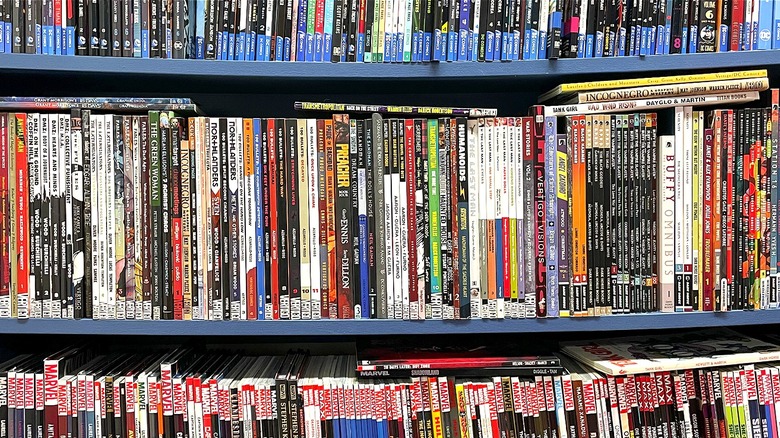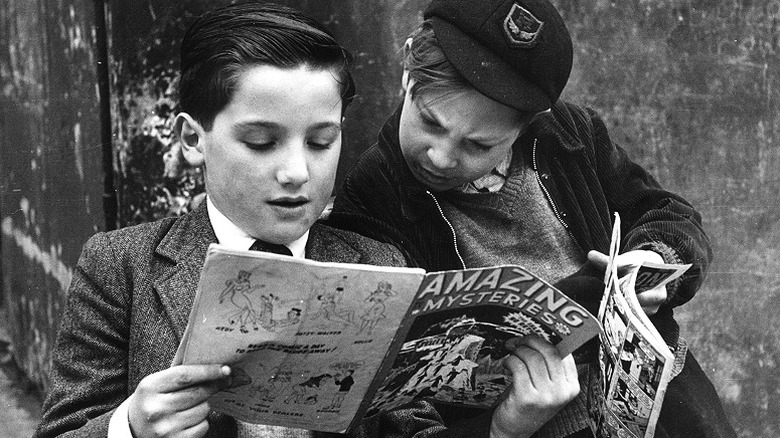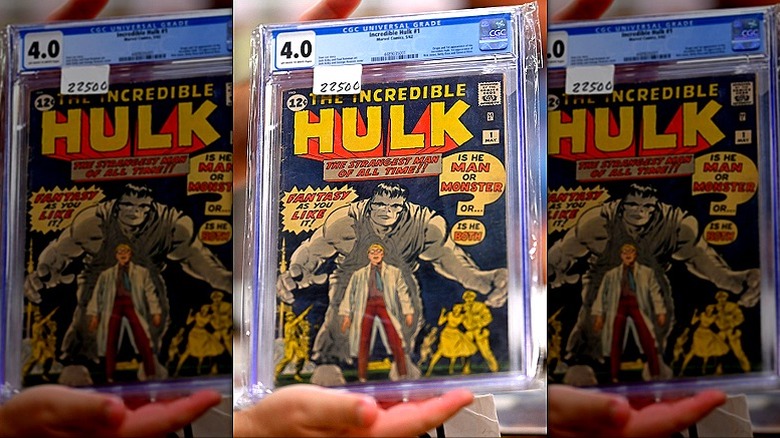How To Tell If Your Old Comic Books Are Worth Anything
In the 1990s, the comic strip "Calvin and Hobbes" pulled some material from the world of comic books — specifically, from those who collect them. Calvin explained to his tiger friend the need to preserve first editions in plastic bags, and every book was a first edition, making them all collector items. Calvin's precious comics were his plan for retirement, on the assumption that any collector comic would end up worth millions. When Hobbes pointed out that kids all across America would have copies of the same book, Calvin put his hopes in other kids' mothers tossing their comics.
These were digs at the comic book collecting craze of the 1980s and early 1990s. The high prices fetched by a few notable comics — a 1991 Sotheby's auction included a copy of "Detective Comics No. 27" (Batman's debut) that went for $55,000, and an "Action Comics No. 1" (Superman's debut) that sold for $29,700, per DC Comics — helped to set off a bubble. Just like Calvin, many took every issue as a potential future windfall. But the distribution model for comics demanded more and more product. Publishers put out more books at higher prices, which ended up tanking the value of the comic and contributed to a rapid collapse of comic book stores.
The industry suffered a crash that completely transformed it. Today, major comic publishers put out a fraction of the books they used to, and the media franchises generated from their books are more important than the comics themselves. The market for comics as a valuable collector's item is full of near-worthless copies. However, you just might have something in your collection that can bring in a respectable sum. Here's what to check for.
Was your comic published before the Bronze Age?
Collectibles of all kinds, from PEZ dispensers to vintage board games that are worth considerably more today, follow a general rule of thumb: the older it is, the more likely it's valuable. Just how old is enough can be a little nebulous, and so it can be with comic books. Anything published after 1980, says Heritage Auctions, will "have little if any value," while Anderson & Garland pushes the cutoff date a decade earlier, relying on the classification of comics into gold, silver, and bronze ages.
For the uninitiated, the Golden Age of comics is considered to run from 1938 to the mid-1950s — 1938 being the first appearance of Superman and the launch of the superhero genre. The Silver Age dates from 1956 to 1970, and the bulk of the comics trade is in books from this era. It saw the debuts of such beloved heroes as Spider-Man and was the launch of the Justice League as its own title.
The Bronze Age runs from 1970 to the present, a little long compared to the others. And when you factor in other criteria for a valuable comic — say, origin stories or the first appearances for beloved characters — it might be tempting to seek a big payday out of a book from the era, perhaps from the early '80s. But the factors that drove the comic book crash of the 1990s started well before. There's the odd title from the 1980s and '90s that could fetch a good price, but the market is generally too saturated with Bronze Age books for them to be worth anything.
Where does your comic fall on a 10-point grading scale?
Age is a very good indicator of whether or not any comics in your collection are potentially valuable. But even if you have a treasure trove of Gold and Silver Age comics — even if you have origin stories and debuts — you aren't necessarily sitting on a gold mine. That's because comics, like most any collectible, are also judged on condition. Many comics were printed on newsprint, a cheap paper easily damaged and yellowed. A Silver Age book like "Amazing Spider-Man No. 1," can go for anything between $7,900 and $241,200, according to Quality Comix, but this all depends on what sort of shape it's in.
Third-party grading services like CGC Comics will assess the condition of your books (for a price). CGC uses a 10-point grading system, with various subgrades. At the bottom of its scale is Poor, or 0.5, that being a potentially valuable collectible comic that has been badly maintained and subjected to serious damage. At the top is a Gem Mint, or 10, in perfect condition. A copy of "The Incredible Hulk No. 1" with a 4.0 grade (pictured) would be considered VG or "a below-average collectible with multiple moderate defects."
CGC admits that it's extremely rare for a book to meet its standards for a 10 grade. Older comics especially are more subject to wear and tear, and weren't published in an era where preservation for value was a top concern; more likely is a book that meets one of its subgrades of 9 , which can still land the right comic into a price range of hundreds of thousands. (Read about the most valuable comic ever sold and what it went for in April 2024.)


